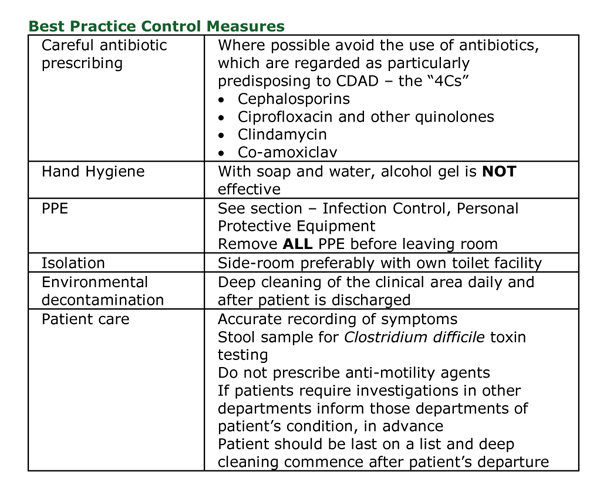Clostridium difficile Associated Disease (CDAD)
The bacterium Clostridium difficile was reclassified in 2016 to Clostridioides difficile but as this has not yet become mainstream this website and the book will continue to use the old name. It is the most common cause of antibiotic associated diarrhoea. It spreads very readily in the hospital environment unless infection control measures are put in place. Clinical features of Clostridium difficile Associated Disease (CDAD) range from asymptomatic carriage through to diarrhoea, toxic megacolon and death.
Mode of Transmission
• Faecal-oral spread
• Clostridium difficile can survive for long periods of time in the environment as spores, which if not removed can then infect new patients
Incubation Period
• Unknown
• Symptoms can occur at any time after prescribing antibiotics however usually 5-10 days
Period of Communicability
• Patients should remain in isolation until 48 hours after symptoms resolve
Mode of Transmission
• Faecal-oral spread
• Clostridium difficile can survive for long periods of time in the environment as spores, which if not removed can then infect new patients
Incubation Period
• Unknown
• Symptoms can occur at any time after prescribing antibiotics however usually 5-10 days
Period of Communicability
• Patients should remain in isolation until 48 hours after symptoms resolve
Diagnosis and management of CDAD see Clinical Scenarios, CDAD

Topics in Infection Control:
All these topics are covered in the book...Ready to buy your copy? Click here to buy your copy of "Microbiology Nuts & Bolts" Its updated and amazingly only slightly larger considering its got 1/3 more in it! (11cmx18cmx2.5cm).
- What is Infection Control?
- Root Cause Analysis (RCA)
- Example of the RCA Process - A patient gets CDAD
- Universal Precautions and Hand Hygiene
- Personal Protective Equipment (PPE)
- Summary of Isolation Priority and Infection Control Precautions
- Influenza
- Tuberculosis (TB)
- Multidrug Resistant Tuberculosis (MDR TB)
- Respiratory Spread Viral and Bacterial Infections
- Clostridium difficile Associated Disease (CDAD)
- How Clostridium difficile can Spread in a Ward Environment
- Diarrhoea and Vomiting (D&V)
- Multiple Antibiotic Resistant Gram-negative Bacteria
- New Antibiotics for Treating Resistant Gram-negative Bacteria
- Meticillin Resistant Staphylococcus aureus (MRSA)
- Panton-Valentine Leukocidin (PVL) Positive Staphylococcus aureus
- Glycopeptide Resistant Enterococcus (GRE)
- Viral Haemorrhagic Fever (VHF)
- Needlestick Injuries
- Needlestick Injury HIV PEP Flowchart
- Outbreaks
All these topics are covered in the book...Ready to buy your copy? Click here to buy your copy of "Microbiology Nuts & Bolts" Its updated and amazingly only slightly larger considering its got 1/3 more in it! (11cmx18cmx2.5cm).

